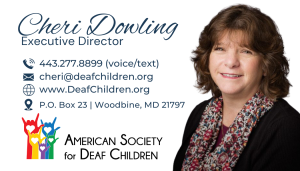
As we honor National Deaf History Month and celebrate the contributions and accomplishments of people who are deaf and hard of hearing, we are proud to recognize the work our predecessors have done and the paths they have paved. We remain mindful of the work still to be done.
At ASDC, we proudly join our allied partners and organizations in celebrating this important month. We will continue to advocate for the right to equitable language access and inclusion.
Get Involved! How can you encourage Deaf Culture awareness and celebrate National Deaf History Month? Here’s a few ideas:
-
-
Advocate by reaching out to companies and governments. Please encourage them to fulfill their legal obligations to d/Deaf and hard-of-hearing individuals.
-
Support Deaf-owned and operated businesses.
-
Donate to organizations providing services to the Deaf and Hard-of-Hearing community. Donate today!
-
Volunteer with Deaf organizations.
-
Learn sign language to promote language inclusion and access for d/Deaf and hard-of-hearing individuals.
-
Educate others by promoting information and news about Deaf Culture and the Deaf and Hard-of-Hearing community.
-
Visit our National Deaf History Month Resources on our ASL Stories Directory.
-
Be sure to follow us on our social media channels as we share daily spotlights about various Deaf/HH role models, organizations, and initiatives throughout the month of April.
We will also share these important spotlights in our weekly ASL Video of the Week emails. These are great tools to use when teaching your students/children about the importance of National Deaf History Month. If you haven’t already, join our email list for weekly updates about our Online Classes and ASL Stories to help you and your family stay in touch.
Join the celebration! Let’s loudly honor those who have worked tirelessly for Deaf/HH children, families, and communities. Together, we can continue their essential work and create inclusive language-diverse communities for EVERY Deaf and Hard-of-Hearing child.
In celebration,
Connect with us!
National Deaf History Month Resources
FACTS
Today, about 11.5 million Americans have some sort of hearing impairment, ranging from difficulty in hearing conversation to total hearing loss. That’s about 3.5 percent of the population. In addition, around 50 million of the population experience some level of tinnitus — a constant ringing in the ears.
National Institute on Deafness and Other Communication Disorders: Statistics About Hearing
A deaf quarterback is credited with the invention of the modern circular football huddle. Read more on this Wikipedia page started by UA students.
The Deaf and the Origin of Hand Signals in Baseball
Deaf Culture Facts That Might Surprise You
Deaf Fun Facts You Need to Know
DEAF HISTORY
April 15, 1817 — The American School for the Deaf, the first public permanent school for Deaf children in the United States, was opened. Located in West Hartford, Connecticut, the school is a nationally renowned leader in providing comprehensive educational programs and services for Deaf and hard-of-hearing students.
April 8, 1864 — Gallaudet University, the first and only higher education institution for Deaf and hard-of-hearing students, was founded. Gallaudet, a private federally chartered research university in Washington, DC, is the only university in the world where students live and learn using American Sign Language and English.
A HISTORY OF DEAF RIGHTS, CULTURE, AND LANGUAGE
Encyclopedia Britannica: History of the Deaf includes information dating back to the 16th century.
People and Events in Deaf History
COMMUNICATION
Healthy Hearing: Communication Tips for Talking to People with Hearing Loss
Disability Language Style Guide: Deaf
American Sign Language Classes
NAD’s Position on Deaf People in Media
MORE IMPORTANT RESOURCES
National Association of the Deaf
National Association of the Deaf Resources
National Institute on Deafness and Other Communicative Disorders: Quick Statistics About Hearing
American Sign Language Spoken Here – “Before William Stokoe‘s groundbreaking research, American Sign Language (ASL) was erroneously viewed as a pantomime, a poor substitute for spoken speech. Now ASL is recognized as a language with its own syntax, morphology, and structure.” With National Science Foundation grants Stokoe and two of his Gallaudet colleagues created the Dictionary of American Sign Language on Linguistic Principles in 1965. National Science Foundation
Deaf President Now – In March 1988, Gallaudet University experienced a watershed event that led to the appointment of the 124-year-old university’s first deaf president. Since then, Deaf President Now (DPN) has become synonymous with self-determination and empowerment for Deaf and hard-of-hearing people everywhere.
How ‘Deaf President Now’ Changed America – A brief history of the movement that transformed a university and helped catalyze the Americans With Disabilities Act.
D-PAN.TV – In March 2016, Deaf Professional Arts Network, known as D-Pan, launched a go-to source for American Sign Language-related content. The highlight of the network is DTV News, featuring Deaf anchors who share national news in ASL along with captioning and voiceovers. The network also offers a variety of entertainment and educational content produced by and starring some of the biggest names in the Deaf community.
Deaf View/Image Art, also known as De’Via, is art that examines and expresses the Deaf experience form a cultural, linguistic and intersectional point of view.
Museum of Deaf History, Arts and Culture – Located in Olathe, Kansas, the museum exposes visitors to the historical experiences of being Deaf and the numerous contributions of Deaf people to the world.
FILM | TELEVISION | BOOKS
“Deaf U” is a Netflix reality series that follows a group of Deaf and heard of hearing students at Gallaudet University, a private university for the education of deaf and hard of hearing in Washington, DC. Released in the fall of 2020, the series is produced by actor, model and deaf activist Nyle DiMarco.
“Audible” is a 2021 short film documenting a Maryland High School for the Deaf high school athlete. It is available on Netflix.
Documentary: “Through Deaf Eyes” — This two-hour documentary explores 200 years of Deaf life in America and presents various perspectives on being deaf. The film is propelled by the stories of people, both eminent and ordinary, and sheds light on events that have shaped Deaf lives. The film includes interviews with prominent members of the Deaf community, including actress Marlee Matlin and Gallaudet University president emeritus I. King Jordan. Interwoven throughout the film are six short documentaries produced by Deaf media artists and filmmakers.
“CODA,” which won an Academy Award for Best Picture and numerous other awards, was the first film to have burned-in subtitles on screen. CODA stands for Child of Deaf Adults. The movie, released in 20201, is about a hearing child in a deaf family who finds herself torn between pursuing her love of music and helping her family’s struggling business. CODA is available on Apple TV+
“Sound and Fury” is a documentary that follows the lives of the Artinians, an extended family with Deaf and hearing members across three generations. Together they confront a technological device that can help the deaf to hear but may also threaten Deaf culture and their bonds with each other. The film was nominated for an Academy Award for Best Documentary Feature and won the National Board of Review Freedom of Expression Award. The documentary is available on Amazon Prime, Apple TV, Sling TV and Roku Channel.
“Deaf Jam: ASL Poets in the Spotlight” showcases students who perform in their first American Sign Language Poetry Performance at Lexington School for the Deaf. The documentary is available on PBS.
“A Look into the Deaf Community” is an 8-minute short that shares information on Deaf culture and American Sign Language. It is available on PBS and part of the Rise and Shine series for children on Arkansas PBS.
“The Power of Silence” is a series on PBS that explores deafness and hearing loss through the many different lenses of education, understanding, compassion and technological advances.
“Why Sign Language was Banned in America” is a 12-minute short on PBS as part of the Otherwords series.
View a more extensive list of movies about the Deaf community, including deaf narrative movies and ASL movies and documentaries.
Films to celebrate national Deaf History Month
FAMOUS DEAF & HARD-OF-HEARING ACTORS & ADVOCATES
Sandra Mae Frank — actress and producer, “New Amsterdam”
Marlee Matlin — author, activist, Academy Award-winning actress for “Children of a Lesser God” in 1986, and starred in “Coda” in 2021
Nyle DiMarco – model, actor, activist, first deaf winner on ”America’s Next Top Model” and “Dancing with the Stars,” an executive producer of “Audible,” and president of the Nyle DiMarco Foundation
Heather Whitestone – Alabama native and the first deaf woman to be crowned Miss America
Juliette Gordon Low – founder of the Girl Scouts
Derrick Coleman – first deaf offensive player in the NFL and played for the Seattle Seahawks, including in the XVLIII Super Bowl
Lou Ferrigno — actor, bodybuilder, and personal trainer, known for his role as the Incredible Hulk






